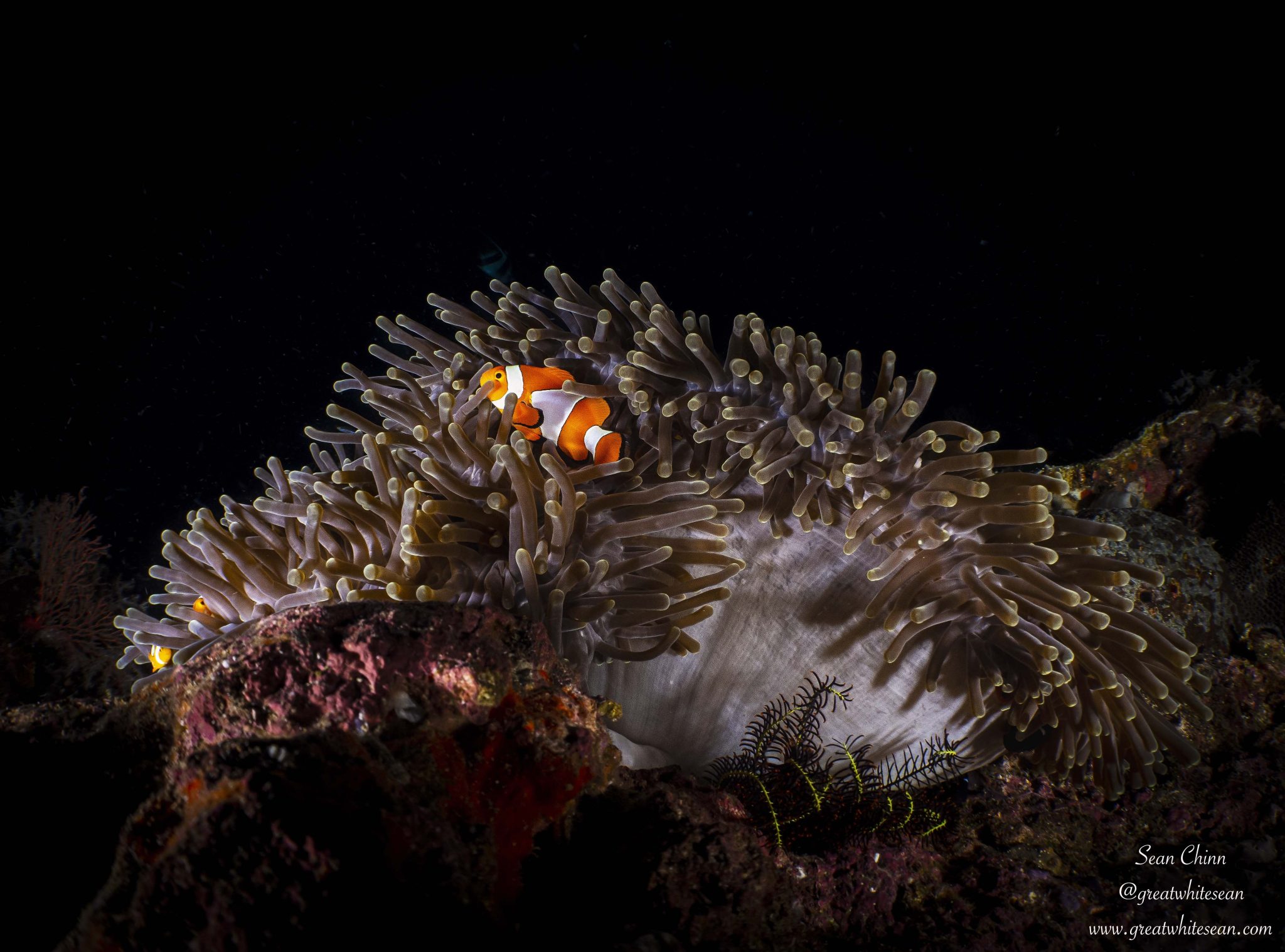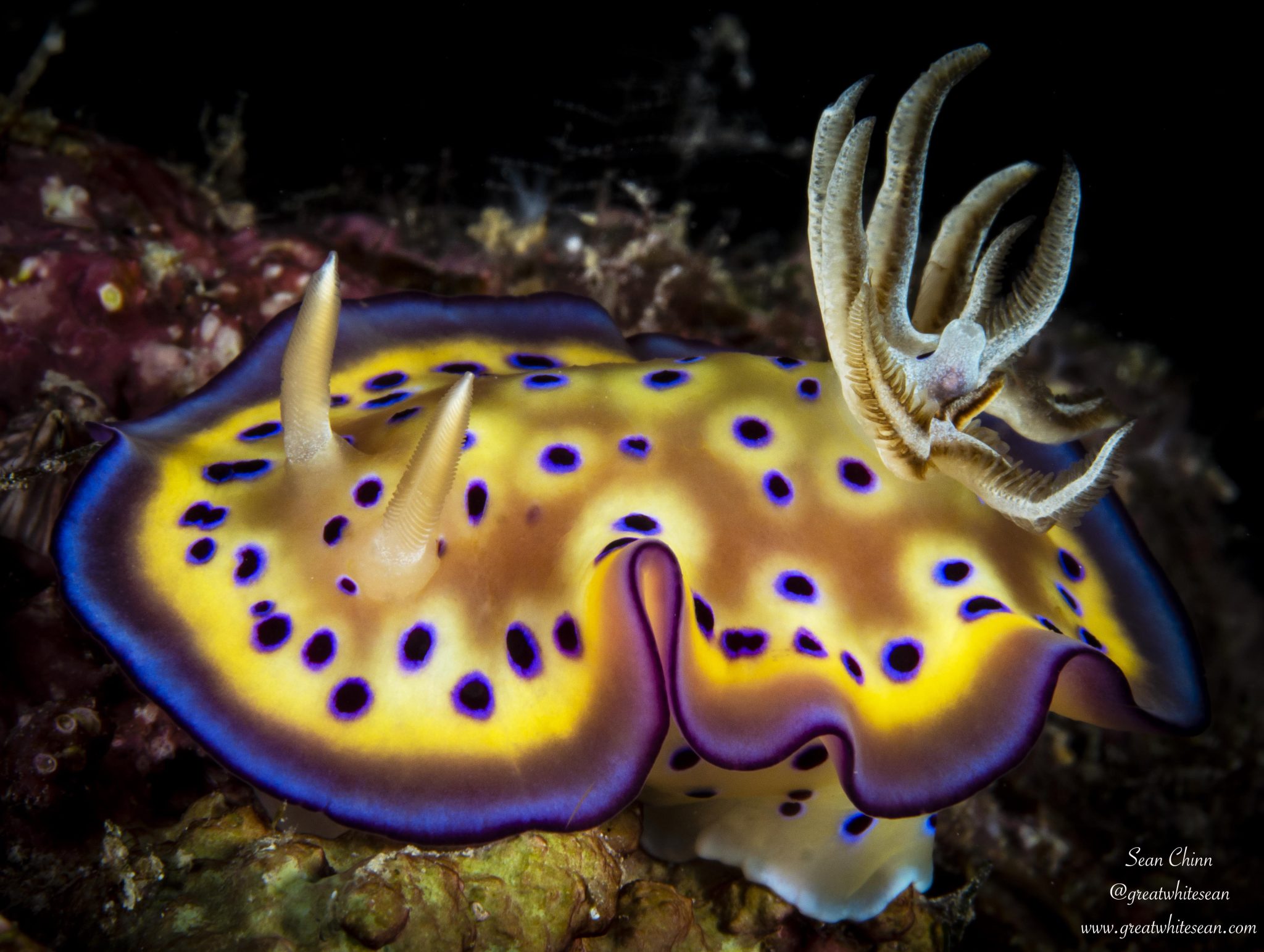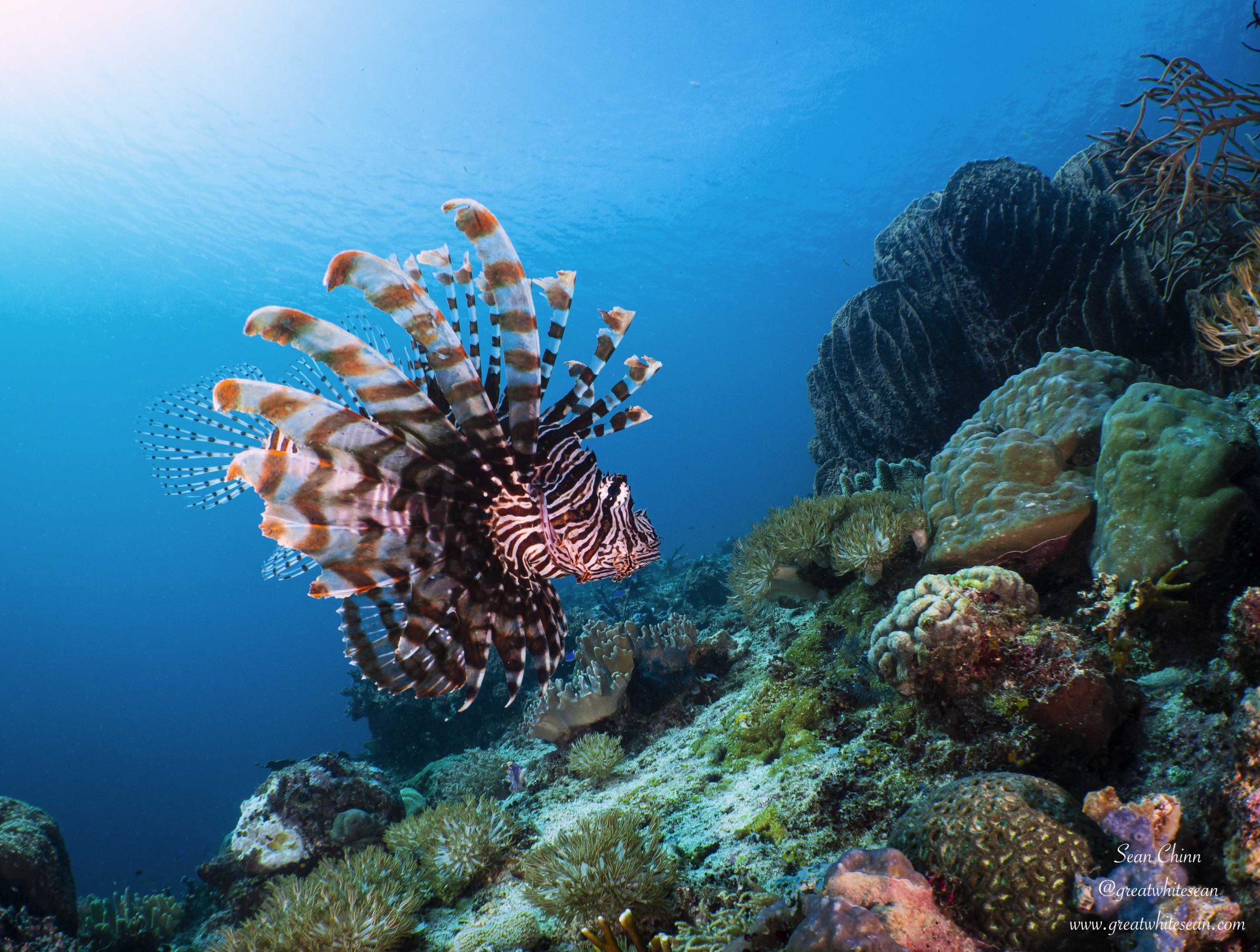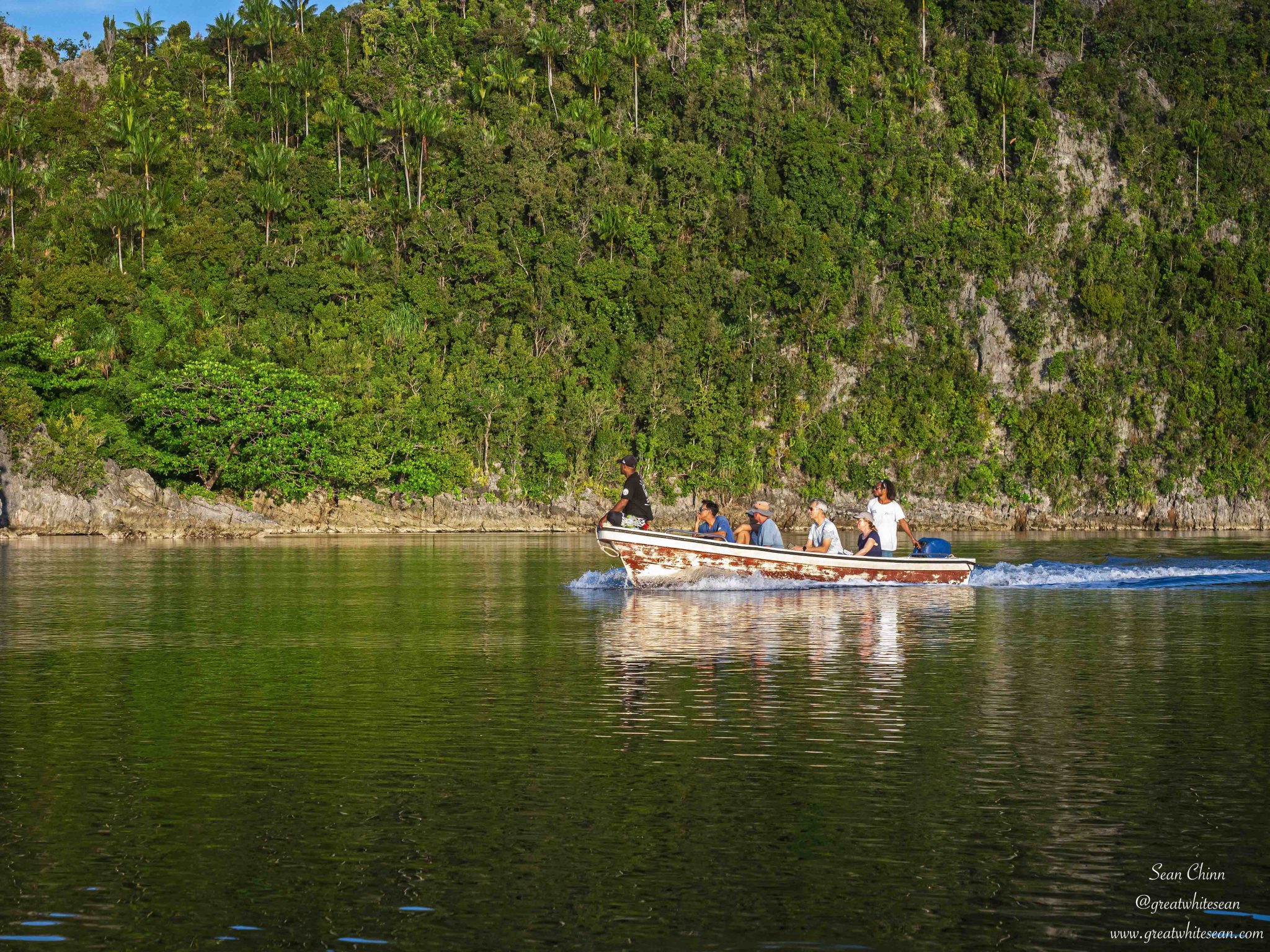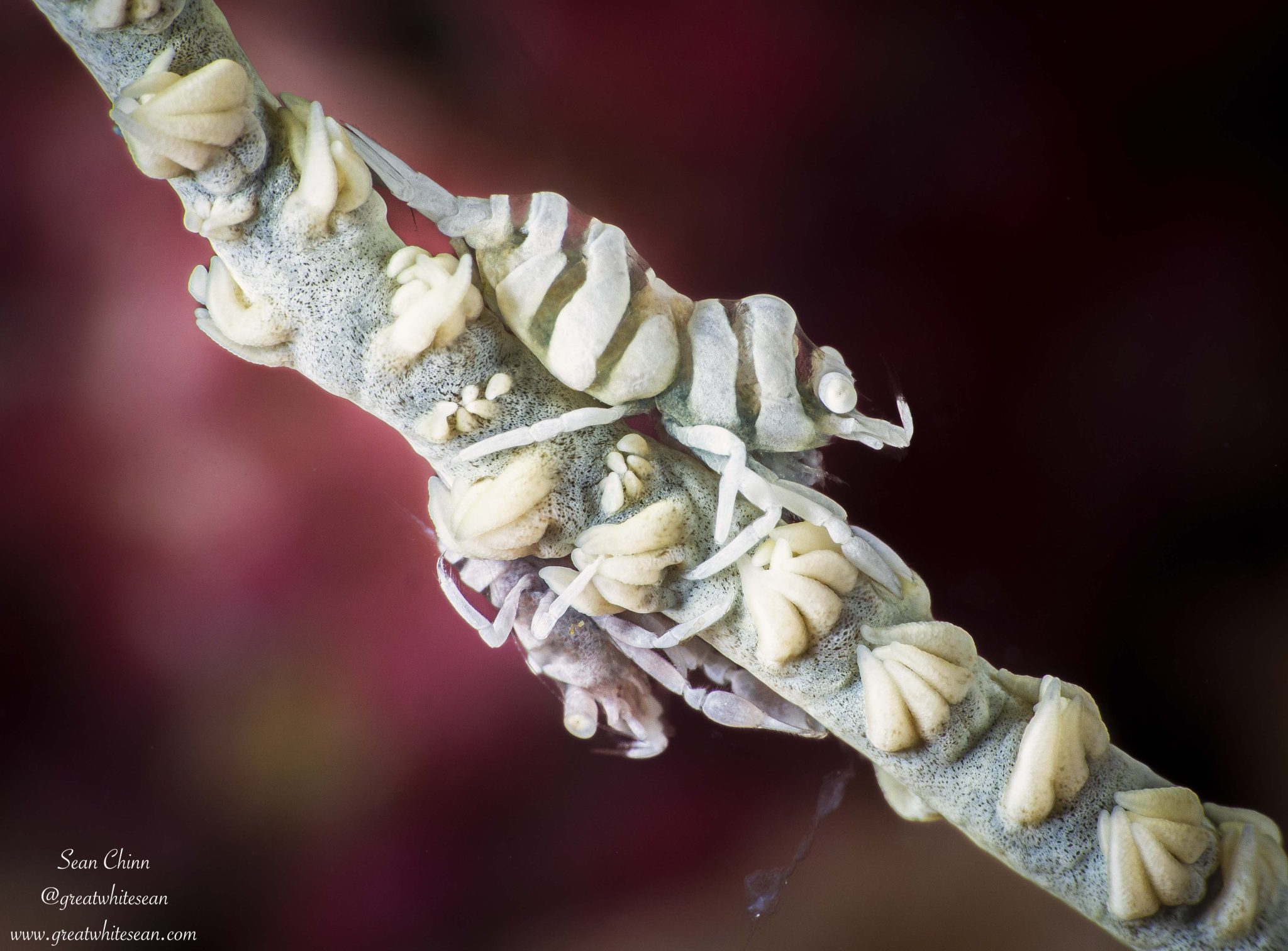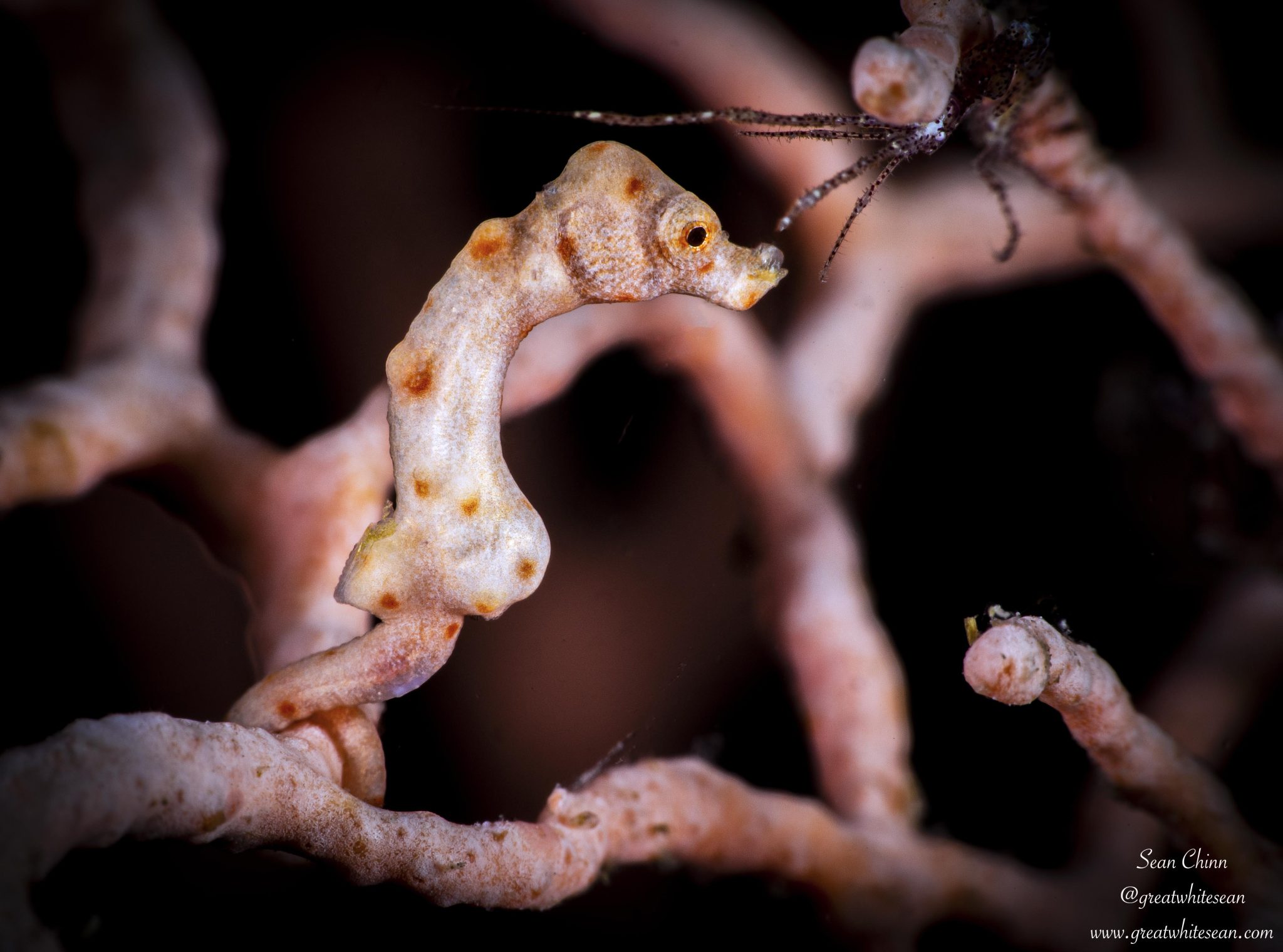News
Ultimate Raja Ampat – The Last Paradise (Part 3 of 3)
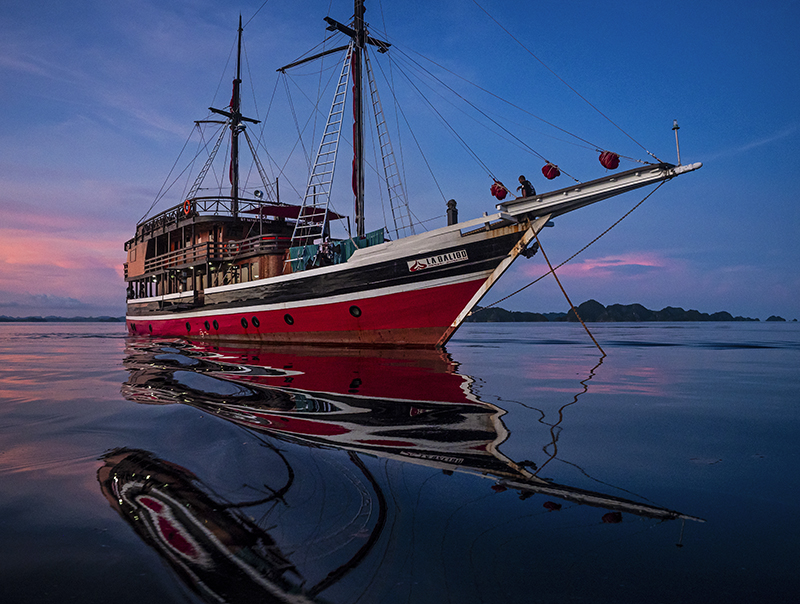
When you visit a place like Raja Ampat over 11 days you really have a lot to talk about. The biodiversity and landscape of the region are inspiring and this is why it’s taken me three blog articles to explain how wonderful this experience was. If you haven’t had the chance already to read the previous two blogs, you can find them here: Part One and Part Two.
After a crossing of around 14 hours – quicker due to a southerly current working with the boat – we found ourselves in Farondi diving Razorback Rock, Anchovy, Nudi Rock (yes, it looks like a nudibranch) and a night dive at Yilliet Slope. I have to admit, it was the south and around Misool that I was really looking forward to on the trip, but it didn’t really get off to the best start and never lived up to the high standards further north had set. To be frank, this was more down to the weather really and the visibility wasn’t brilliant.
A storm meant the dives were pretty dark and in fact, the dive at Anchovy in particular was more like a night dive than a day dive. Unfortunately, we can’t control the weather and on other days these sites could have delivered a lot more. The sea fans on each dive were equally as impressive as further north, and I’d probably say more abundant. The dark atmosphere did mean I could try some fun and different shots with clownfish in anemones but I probably should have switched to macro quicker that day. There are always fun critters to find on every dive site and Nudi Rock showed just that, with a few sea fans being infested with skeleton shrimp. While I’ve seen skeleton shrimp before, I’d never seen anything like this; every bit of the fan was covered. There must have been thousands and it was quite fitting that it was actually Halloween as well.
After a moody day, where I’m guessing the weather gods were celebrating Halloween, I finally switched to macro on the night dive and my photography was rewarded for it. An elusive pygmy squid started the dive but didn’t allow me to get a photo with its tricky movements. Still fun to watch and see, before once again, nudibranch were the stars of the show. A free swimming black and orange flatworm mesmerised mid-water, but it was a super tiny nudibranch of only around a centimetre long that I admired most and took some time to photograph. Then it was the turn of crustaceans once again. A couple of different types of decorator crab, a couple of lobster species and a whip coral shrimp finished off the dive after the sea slug starter.
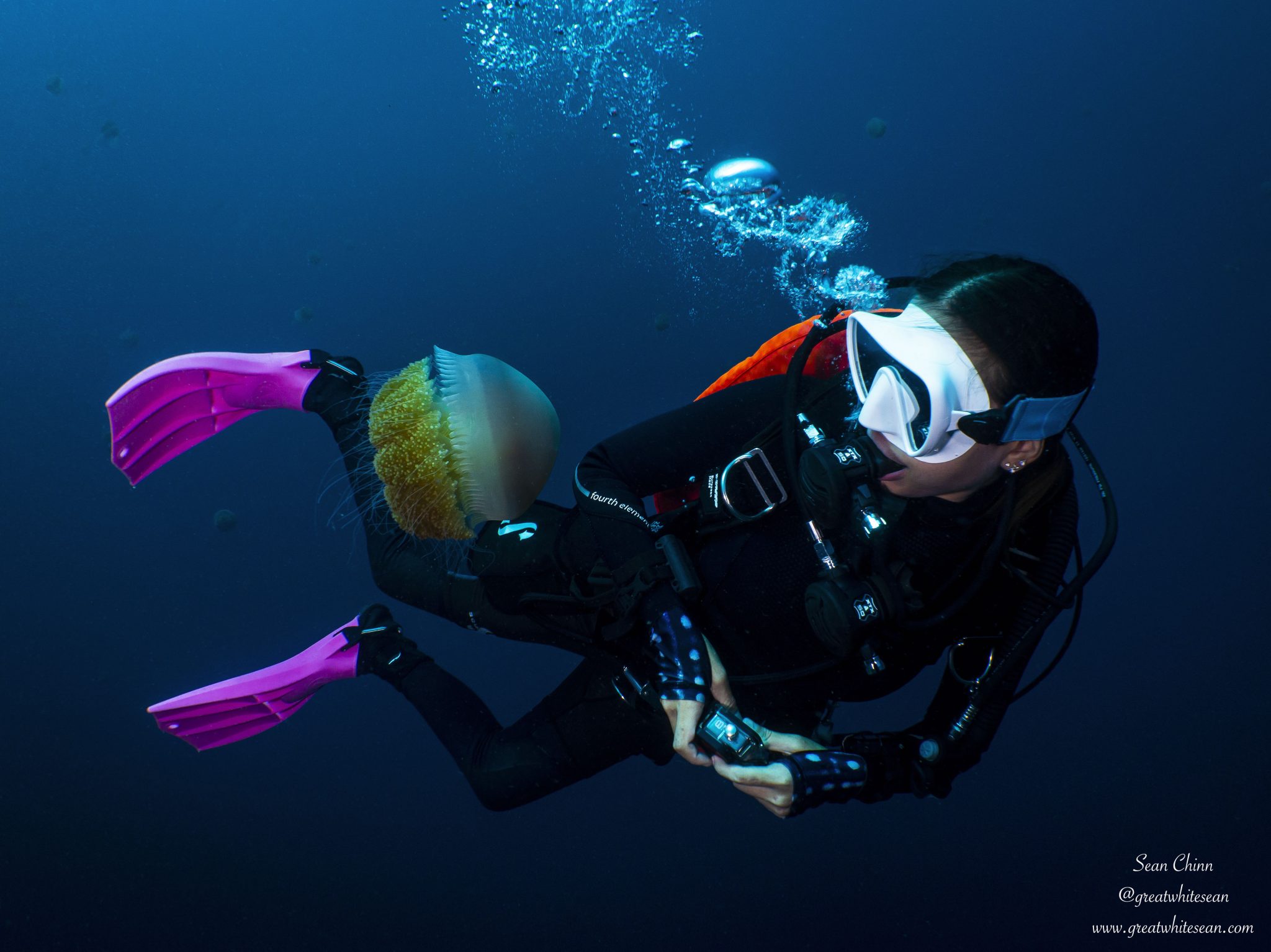
It was a fun game of dodge the jellyfish on the dive at Four Kings. Such a unique experience for me on a dive
The next day, the wide-angle opportunities improved drastically. Although, rather annoyingly, I stuck with macro on the first dive at Neptune’s Fan Sea. I hadn’t seen a Denise pygmy seahorse before and was desperate to get a shot of one before the trip was over. This site was a great opportunity. It was sea fan heaven, but that does mean there’s a lot more places to look. The topography was incredible on the dive, a cliff of sea fans greeted us and made wide angle a good option. It was such a relaxing dive with a small school of bumphead parrotfish making the occasional pass, and the soft coral formations continued in huge numbers and were so impressive. I did manage a couple of nice nudibranch shots but the seahorse remained elusive for our group.
I decided to switch back to wide angle for Four Kings and that was certainly the right choice. A swarm of jellyfish greeted us on the dive and made it one of the most memorable of the trip. There was so much life around the pinnacles as the fish life danced a merry dance. The game of dodge the jellyfish entertained throughout and it was interesting to see as they’d get trapped on the sea fans. Something I’d never experienced before on such an incredible dive site. Barracuda point finished off the day’s diving in relaxing style, with a stunning top reef. Yes, I saw my first two Denise pygmy seahorses here, but no, I had my wide angle on. It was a great site for photographing lionfish though and there was a small school of barracuda giving the site its name.
Although “The Jellyfish Dive” was an amazing highlight of the day, it wasn’t actually diving that finished the day in style. A sunset cruise in Wayilbatan delivered those feels. You know the ones, when you’re in a beautiful place, at a beautiful time and with only a handful of people. You get that completely content feeling and just forget all your worries and live for that moment. It was a spontaneous trip out as well, as the itinerary was to trek to Love Lagoon. However, the guests on the trip before advised it would probably be best to take it off the itinerary for a bit. Unfortunately, with a forced Covid break and lack of maintenance care, the stairs have become slightly dangerous for trekking. The alternative didn’t disappoint and in fact excelled. An exploratory journey, where even the crew didn’t really know where we were going, took us to some breathtaking views with an amazing sunset backdrop. The glass like sea provided the perfect stage with its mirror like reflections. Then in the shallows we could see every bit of coral and life we passed, before tilting your head and following the cliff face up to amazing limestone islands covered in lush green rainforest. Just beautiful!!
With only two days and six dives left, one of my main goals was to photograph a Denise pygmy seahorse. I was in a catch 22 though, there were some memorable wide-angle dives to come. Starting with Boo Window and the arch swim through creating a dramatic image with a diver. I was happy with those wide-angle photos, but guess what? We did see a pygmy again. Still, I wasn’t to be defeated and we also had the friendliest hawksbill turtle on the dive too.
Next up was Shadow Reef (a.k.a Magic Mountain), in the hope to see the majestic Oceanic manta rays. We entered through a concentrated section of bad visibility and then the weather also changed with a storm passing over while we were below. It went dark underwater once more and unfortunately there were no mantas to be seen during the dive. It was still such a special dive site with schooling jackfish, a small school of batfish, another friendly hawksbill, Napoleon wrasse and my first whitetip reef sharks of the trip.
I had to switch to macro and hope for a pygmy at Whale Rock. No such luck unfortunately, but it was an amazing macro dive with numerous crustaceans and my favourite photos of whip coral shrimp. A Pikachu nudibranch was another great nudibranch find by one of my dive buddies. There might have been no seahorse due to skeleton shrimp infesting all the sea fans, but I was really happy with the macro photography success on this dive.
The night dive at Romeo carried on with the magnificent macro theme. We were there to try and see a walking shark again but unfortunately it remained elusive on this dive. Typical, when I have all my equipment working! However, a friendly cuttlefish, some pygmy squid and more crustaceans made the dive memorable still. Can I get to photograph a Denise pygmy with only two dives left?? I really hope so…
We finished our diving in Raja Ampat at Tank Rock and Boo West. I was advised both dives would be preferably wide angle. I knew I needed to stick to macro though, with seeing three Denise pygmies previously while shooting wide angle. I didn’t want to miss the opportunity before I left Raja Ampat. Then, as the dive started, I began to lose hope once again. Skeleton shrimp filled the sea fans once more and I thought that would be enough to scare any seahorse to another site. BUT!! It wasn’t long before my guide Aghi worked his magic and found a beautiful little Denise pygmy seahorse for me to photograph. Phew!!! The pressure was off for the dive early on, but now I just needed to get a photo of these difficult to photograph critters. Skeleton shrimp were still sharing the sea fan with the seahorse and parts of them tended to get in the way but without a nice composition of both. I did manage to get some decent in focus shots and my diving in Raja Ampat was complete. Mission successful for another new species for me. An orangutan crab and some nice photos of the skeleton shrimp completed the dive before a switch back to wide angle for Boo West.
While the visibility wasn’t great (but not terrible) for the final dive, it was another stunning dive in paradise, with once again amazing sea fans littering the reef wall in pristine condition. Then came my favourite schooling fish to see, as what must have been around a hundred batfish/spadefish were seen cruising in the current. Such an amazing sight, with a couple of blacktip reef sharks also coming to say goodbye. The real surprise and the memorable moment of the dive came from a tiny cuttlefish that was just bobbing around in the blue away from the reef. I really wasn’t expecting to see it there, as I caught it in the corner of my eye. It took me a second to confirm I wasn’t seeing things but sure enough it was there. It was super friendly and came right up to my mask and I can only hope it stayed safe away from the protection of the reef once we left.
I’d been desperate to visit Raja Ampat for so long and thankfully it didn’t disappoint. La Galigo was the perfect vessel, with the perfect hosts to explore the area with that really made my time extra special. It’s certainly a place I won’t just want to visit once. I could see myself returning again and again and still being amazed by all the things I’d see. I ticked off so many new species in this biodiversity hotspot and took countless photos.
I now had a long journey home of two days, with 22 hours in Jakarta airport. I wasn’t fazed though, as I had so many photos to go through to keep me entertained and those memories kept me smiling throughout the journey. I’d recommend everyone (not just divers) to put Raja Ampat on your travel bucket list. It really is a true paradise and I can perfectly understand where the nickname – “The Last Paradise” comes from.
For more information about diving in Raja Ampat:
Whatsapp: +62 812 2000 2025
News
Book Review: Fire on Monroe Bravo by Fred Lockwood

Fire on Monroe Bravo is the latest book in the Jack Collier series by Fred Lockwood. Our story begins with our lead characters, Jack and Sandro, owners of Marine Salvage & Investigation Company, arriving on the Monroe Bravo Oil & Gas Platform in the North Sea. Having secured a contract for their vessel the MV Stavanger to act as support ship to the platform for TransGlobal Oil, our protagonists are on a celebratory visit.
However almost as soon as they arrive a series of explosions rock the platform, causing huge damage, loss of life and the very real danger of a massive human, ecological and financial disaster.

As the danger mounts for both our heroes and the surviving workers, Jack and Sandro will have to escape the inferno, all while trying to save the platform and the men still trapped unable to help themselves.
The disaster sets the scene for the unfolding story lines following the fate of the platform and our main characters, the police investigation into a suspected terrorist act and the actions of TransGlobal Oil as they attempt to navigate the pubic outcry and financial repercussions.
In his eighth book, Fire on Monroe Bravo, Fred Lockwood delivers an explosive thriller, with plenty of above and in-water drama, and our heroes fighting for survival, what more can you ask for?
We thoroughly recommend this read and look forward to the next in the series. For more information about his book series, you can check out the reviews of his previous books here on Scubaverse.
- Title: Fire On Monroe Bravo
- Author: Fred Lockwood
- ISBN: 979-8325324536
Available in a paperback version and for Kindle from Amazon and book stores.
Blogs
Alonissos: The complete diving destination (Part 1)

In June we were incredibly fortunate to be invited to dive in Alonissos, a small Greek Island in the Sporades island chain located in the North Aegean Sea. While I have long been a big fan of the Greek Islands as a great holiday destination, I had not had the opportunity to do any diving on previous visits and Mike and I were extremely excited to see what Alonissos had to offer both above and below the surface!

The Sporades are easily accessible via the airport in Skiathos (the first island in the chain), which is served by Jet2 flights from all major UK airports from May through October. Numerous ferries and charter boats make island hopping from Skiathos Town a breeze. After an hour boat ride, the picturesque port of Patitiri was a wonderful introduction to Alonissos, where we were met by our gracious hosts Kostas of Albedo Travel and Dias of Alonissos Triton Dive Center. Mike and I were delighted to be staying at the Paradise Hotel, aptly named for its stunning views over the sea and great location for walking to the waterfront.

Alonissos is beautifully situated in the National Marine Park of Alonissos and the Northern Sporades, the largest marine protected area in Europe. The surrounding seas offer fabulous marine life, including incredibly rare species such as the Mediterranean monk seal. They boast deep walls covered in gorgonians and sponges, stunning topography with caverns, swimthroughs and pinnacles, and the first accessible ancient shipwreck from 500BC!

In locations where historical sites have been reported, the waters are largely restricted, but with collaboration between government, underwater archeologists and dive centres, incredible underwater museums are being created for a truly unique diving experience. Alonissos is home to the first of these, the Ancient Shipwreck of Peristera Accessible Underwater Archeological Site. The chance to dive into history (along with reports of healthy reef life and amazing underwater topography) meant Mike and I were keen to get in the water.

Our introduction to the diving around Alonissos was at the Agios Georgios Pinnacles, in the channel between Alonissos and Skopelos. This fantastic site was named “The Chimney,’ and proved to have a huge amount to see. We got to a decent depth here (over 25m), and marvelled at a colourful reef wall with a wonderful swim through whose rocky walls were absolutely covered with life. As well as brilliant topography there was no shortage of macro life here. We saw numerous nudibranchs, five different species in total. The second dive at Mourtias reef nearby was a shallower dive along a nice wall with lots of crevices. Several moray eels and grouper called this site home. We enjoyed looking in the crevices for lobster and smaller benthic life, such as cup corals and tunicates.

Our itinerary allowed us two dives a day with afternoons left to explore the island with our hire car and evenings to enjoy the famous Greek hospitality. This proved to be a lovely mix of in-water and land based diversions.

The next days diving to the Gorgonian Gardens and Triton’s Cave was to be even better! These two stunning sites are nothing short of fabulous. The Gorgonian Gardens was a deep wall near to the Agios Georgios islands. The ever-present currents in this deep channel meant that the sea life was amazing … the namesake Gorgonian sea fans dotted the wall at a depth of 30 to 50 meters, getting ever larger the deeper we went. Above 30m was by no means less beautiful, with sponges, corals, scorpionfish, moray eels and some rare and colourful nudibranchs.

The second shallower dive of the day was to Triton’s Cave or the Cavern of Skopelos, on the east side of that island. The spectacular rock formations had wild striations both above and below the water making a truly epic topography. The cavern entrance was at 14m, and big enough for a buddy pair, winding up to 6m and passing two beautiful windows out into the blue. Emerging from the cavern, the light at the shallower depths and the incredible rock formations made for a fantastic gentle swimming safety stop and we all surfaced by the boat with massive grins.

Check out our next blog :Alonissos: The complete diving destination (Part 2)” to hear about our amazing dive on the 2500 year old Peristera Wreck!
Thanks to:
Alonissos Triton Dive Center https://bestdivingingreece.com/
Albedo Travel https://alonissosholidays.com/activities/
Paradise Hotel https://paradise-hotel.gr/
Alonissos Municipality https://alonissos.gr/en/
-

 Blogs2 months ago
Blogs2 months agoDiving With… Nico, Ocean Earth Travels, Indonesia
-

 News1 month ago
News1 month agoMurex Bangka Announce New Oceanfront Cottages & Beachfront Dining
-

 Blogs2 months ago
Blogs2 months agoA new idea in freediving from RAID
-

 Marine Life & Conservation1 month ago
Marine Life & Conservation1 month agoIceland issue millionaire whale hunter a licence to murder 128 vulnerable fin whales
-

 Marine Life & Conservation2 months ago
Marine Life & Conservation2 months agoThe Shark Trust Great Shark Snapshot is back
-

 News3 months ago
News3 months agoCharting New Waters; NovoScuba Goes Global with the Launch of their Revolutionary Dive Training Agency!
-

 Gear News1 month ago
Gear News1 month agoNew Suunto Ocean – a dive computer and GPS sports watch in one for adventures below and above the surface
-

 Marine Life & Conservation Blogs2 months ago
Marine Life & Conservation Blogs2 months agoBook Review: Plankton


